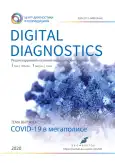MosMedData: data set of 1110 chest CT scans performed during the COVID-19 epidemic
- Authors: Morozov S.P.1, Andreychenko A.E.1, Blokhin I.A.1, Gelezhe P.B.1, Gonchar A.P.1, Nikolaev A.E.1, Pavlov N.A.1, Chernina V.Y.1, Gombolevskiy V.A.1
-
Affiliations:
- Research and Practical Clinical Center for Diagnostics and Telemedicine Technologies, Department of Health Care of Moscow
- Issue: Vol 1, No 1 (2020)
- Pages: 49-59
- Section: Datasets
- URL: https://journals.rcsi.science/DD/article/view/46826
- DOI: https://doi.org/10.17816/DD46826
- ID: 46826
Cite item
Abstract
With the ongoing COVID-19 pandemic decreasing availability of polymerase chain reaction with reverse transcription and the snowballing growth of medical imaging, especially the number of chest computed tomography (CT) scans being performed, methods to augment and automate the image analysis, increasing productivity and minimizing human error are of particular importance. The creation of high-quality datasets is essential for the development and validation of artificial intelligence algorithms. Such technologies have sufficient accuracy in diagnosing COVID-19 in medical imaging. The presented large-scale dataset contains anonymized human CT scans with COVID-19 features as well as normal studies. Some studies were tagged by radiologists using binary pixel masks of regions of interest (e.g., characteristic areas of consolidation and ground-glass opacities). CT data were acquired between March 1, 2020, and April 25, 2020, and provided by municipal hospitals in Moscow, Russia. The presented dataset is licensed under Creative Commons Attribution-NonCommercial-NoDerivs 3.0 Unported (CC BY-NC-ND 3.0).
Keywords
Full Text
##article.viewOnOriginalSite##About the authors
Sergey P. Morozov
Research and Practical Clinical Center for Diagnostics and Telemedicine Technologies, Department of Health Care of Moscow
Email: morozov@npcmr.ru
ORCID iD: 0000-0001-6545-6170
SPIN-code: 8542-1720
MD, PhD, Professor
Russian Federation, MoscowAnna E. Andreychenko
Research and Practical Clinical Center for Diagnostics and Telemedicine Technologies, Department of Health Care of Moscow
Email: a.andreychenko@npcmr.ru
ORCID iD: 0000-0001-6359-0763
SPIN-code: 6625-4186
MD
Russian Federation, MoscowIvan A. Blokhin
Research and Practical Clinical Center for Diagnostics and Telemedicine Technologies, Department of Health Care of Moscow
Email: i.blokhin@npcmr.ru
ORCID iD: 0000-0002-2681-9378
SPIN-code: 3306-1387
MD
Russian Federation, MoscowPavel B. Gelezhe
Research and Practical Clinical Center for Diagnostics and Telemedicine Technologies, Department of Health Care of Moscow
Email: gelezhe.pavel@gmail.com
ORCID iD: 0000-0003-1072-2202
SPIN-code: 4841-3234
MD, PhD
Russian Federation, MoscowAnna P. Gonchar
Research and Practical Clinical Center for Diagnostics and Telemedicine Technologies, Department of Health Care of Moscow
Email: a.gonchar@npcmr.ru
ORCID iD: 0000-0001-5161-6540
SPIN-code: 3513-9531
MD
Russian Federation, MoscowAlexander E. Nikolaev
Research and Practical Clinical Center for Diagnostics and Telemedicine Technologies, Department of Health Care of Moscow
Email: a.e.nikolaev@yandex.ru
ORCID iD: 0000-0001-5151-4579
SPIN-code: 1320-1651
MD
Russian Federation, MoscowNikolay A. Pavlov
Research and Practical Clinical Center for Diagnostics and Telemedicine Technologies, Department of Health Care of Moscow
Email: n.pavlov@npcmr.ru
ORCID iD: 0000-0002-4309-1868
SPIN-code: 9960-4160
MD, MPA
Russian Federation, MoscowValeria Yu. Chernina
Research and Practical Clinical Center for Diagnostics and Telemedicine Technologies, Department of Health Care of Moscow
Email: v.chernina@npcmr.ru
ORCID iD: 0000-0002-0302-293X
SPIN-code: 8896-8051
MD
Russian Federation, MoscowVictor A. Gombolevskiy
Research and Practical Clinical Center for Diagnostics and Telemedicine Technologies, Department of Health Care of Moscow
Author for correspondence.
Email: g_victor@mail.ru
ORCID iD: 0000-0003-1816-1315
SPIN-code: 6810-3279
MD, PhD, MPH
Russian Federation, MoscowReferences
- Ai T, Yang Z, Hou H, et al. Correlation of chest CT and RT-PCR testing in Coronavirus Disease 2019 (COVID19) in China: a report of 1014 cases. Radiology. 2020;296(2):E32–E40. doi: 10.1148/radiol.2020200642
- Handbook of COVID-19 Prevention and Treatment. Ed. by T. Liang. Zhejiang University School of Medicine; 2020. 68 p.
- Huang Z, Zhao S, Li Z, et al. The battle against Coronavirus Disease 2019 (COVID-19): emergency management and infection control in a Radiology Department. J Am Coll Radiol. 2020;17(6):710–716. doi: 10.1016/j.jacr.2020.03.011
- Morozov SP, Gombolevskiy VA, Cherninа VY, et al. Prediction of lethal outcomes in COVID-19 cases based on the results chest computed tomography. Tuberculosis and Lung Diseases. 2020;98(6):7–14. (In Russ.) doi: 10.21292/2075-1230-2020-98-6-7-14
- Morozov S, Guseva E, Ledikhova N, et al. Telemedicine-based system for quality management and peer review in radiology. Insights Imaging. 2018;9(3):337–341. doi: 10.1007/s13244-018-0629-y
- Li L, Qin L, Xu Z, et al. Using artificial intelligence to detect COVID-19 and community-acquired pneumonia based on pulmonary CT: evaluation of the diagnostic accuracy. Radiology. 2020;296(2):E65–E71. doi: 10.1148/radiol.2020200905
- Ucar F, Korkmaz D. COVIDiagnosis-Net: Deep Bayes-SqueezeNet based diagnosis of the coronavirus disease 2019 (COVID-19) from X-ray images. Med Hypotheses. 2020;140:109761. doi: 10.1016/j.mehy.2020.109761
- Vremennye metodicheskie rekomendatsii “Profilaktika, diagnostika i lechenie novoi koronavirusnoi infektsii (COVID-19). Versiya 9” (utv. Ministerstvom zdravookhraneniya RF 26 oktyabrya 2020). Available from: https://base.garant.ru/74810808/
- Morozov SP, Protsenko DN, Smetanina SV, editors. Radiation diagnostics of coronavirus disease (COVID-19): organization, methodology, interpretation of results: guidelines. Series “Best practices of radiation and instrumental diagnostics”. Issue 65. Moscow; 2020.
- Morozov SP, Vladzymyrskyy AV, Klyashtornyy VG, et al. Clinical acceptance of software based on artificial intelligence technologies (radiology). Series “Best practices in medical imaging”. Moscow; 2019. Issue 57.
- Cohen JP, Morrison P, Dao L. COVID-19 Image Data Collection [Internet]. 2020 [cited 2020 Mar 25]. Available from: https://arxiv.org/abs/2003.11597
- Jun M, Cheng G, Yixin W, et al. COVID-19 CT lung and infection segmentation dataset. Verson 1.0. 2020. doi: 10.5281/zenodo.3757476
Supplementary files












